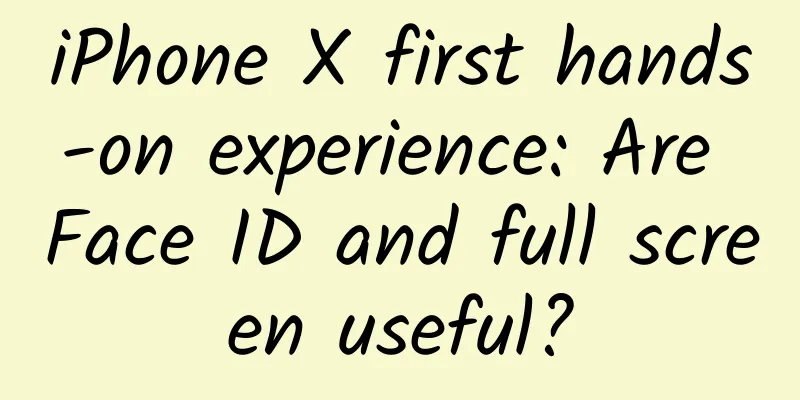iPhone X first hands-on experience: Are Face ID and full screen useful?

|
"Consumers don't know what they need until we come up with our products, and then they realize, this is what they want." This quote from Steve Jobs at a press conference has attracted countless interpretations and citations. However, if the iPhone product line is used as a standard, it seems that Apple has already thrown it into an abandoned warehouse in recent years. Today, I am talking about this again because of iPhone X. Although it seems to the outside world that "the special-shaped full screen and front fingerprint recognition are very likely to be hastily implemented", at the same time, "subversion and habit are two sides of the same coin", so which one is iPhone X? This hands-on experience may find the answer. Appearance: Try to solve it in three paragraphs The full screen will bring a better feel, and this advantage will be more prominent when the phone becomes rounder. Although there are many products with full screen in the second half of the year, only the Samsung S8 series and the all-ceramic version of Xiaomi MIX 2 can be compared with it in terms of the smoothness of the touch - this is the feeling that the iPhone X gives people when they first use it. The front side reflects all the technological innovations of the iPhone X, but it also attracts the most complaints. During my time with the device, I found the following issues with its appearance: - The special-shaped full screen gives Apple the opportunity to show off eight sensors, but it makes the various displays less regular;- The bottom display is much more transparent because there is no fingerprint button, but the horizontal line somewhat destroys the overall picture after the screen is turned on; - Although it is called a full screen, if you look closely you will find that the black border area is quite wide (it is said to be to prevent falls). In short, there are both breakthroughs and setbacks, but if expressed from a personal perspective, X's positive appearance is very high. Apple has returned to the glass camp on the back and added 7 layers of coating to the glass. The white color even has a "shell gloss effect", but this still cannot resist the aesthetic compromise of the vertical lens (the positions of the front lens, sensor and traditional rear lens conflict), or it is ugly. But there is a remedy - buy a black iPhone X, the overall feel and glossiness will be greatly improved. Face ID: A new era of biometrics Face ID (Chinese name: Face ID) is the most discussed but most inconclusive part before - because countless Android manufacturers have tried facial recognition, but the difference in basic technical principles makes the experience of iPhone X and "other mobile phones" different. Specifically, Apple uses infrared structured light to build a miniature 3D facial recognition system: a projector plus a receiver, allowing infrared to scan the 3D surface of a person's face. This technology breaks through the two major problems of current facial recognition: 3D structured light can solve the security issues of plane recognition and greatly improve the recognition angle - you can unlock it at a very strange angle. Other phones require you to adjust your face to a position that is relatively perpendicular to the lens. This will significantly improve the unlocking experience. And it is obvious: infrared light will not be affected by the brightness of the ambient light, and unlocking late at night will not reduce the unlocking speed and accuracy. These are two obvious breakthroughs brought by hardware. But when it comes to experience, it is the combination of hardware, system and even different usage scenarios. For example, if a phone vibrates and receives a message, the message will be displayed directly if the owner picks up the phone; but if someone else picks up the phone, the phone will recognize the facial data and the message will not be displayed. There are many other interactive upgrades like this, but we don’t have enough time to experience them on site so we can’t list them all. Of course, as a new technology, people are more concerned about safety issues. 1 When I was sleeping with my eyes closed, my wife swiped away my money? No, for it to identify the eye position, the eyes must be open ; 2 Deceived by the photo? No, it is an infrared depth image, not two-dimensional; 3 Deceived by the mask? No, Apple worked with Hollywood to make a lot of masks to train the A11's neural network to prevent deception; 4 Makeup cannot be recognized? No, it can detect small changes in the face, including taking off glasses; 5 Worried about not being recognized after getting tanned? No, Face ID collects depth information, which has little to do with color; 6 Worried that you won’t be recognized when wearing glasses? No, as long as it does not block the infrared light of 940 nanometers from passing through; but sunglasses may indeed cause recognition failure, which has nothing to do with the color of the lens, but mainly depends on whether it blocks the infrared light of 940 nanometers. 7 Are you worried that you have gained weight and your face cannot be recognized? No, the A11 Bionic chip will learn and record the subtle changes in your face every day, as long as your face does not change drastically; From this you can easily find that Face ID is not a permanent lock. Its focus is on self-learning and evolution: if the owner shaved his beard today, it will hesitate for a while, thinking that this person seems to be the owner but not sure. In this case, it will ask for a password and record the owner's appearance without a beard; but if the owner's wife directly unlocks the phone with the password, it will also know that this person is completely different from the owner and there is no need to learn and record her face. Of course, Face ID has certain limitations. For example, twins who look very similar may be mistaken for each other, and it is not recommended for children under 13 years old because their facial features have not yet matured. The above is our experience with Face ID on iPhone X. Due to the lack of confidence in new technologies, or perhaps out of obsession with habits, there have been many rumors that Apple will restart fingerprint recognition in the next generation of products - under-screen fingerprint. But considering maturity alone, such concerns now seem a bit unnecessary. About UI: In addition to complaining about bangs, there are new topics Although Apple has placed as many as eight sensors in the "bangs" area, and it can be said that a large number of changes in the new phone are in this area (of course the A11 Bionic chip is still the core), it seems that people still complain unreservedly about this special-shaped cut screen. In fact, many previous iPhone X real machine UI exposure pictures show that the display of applications in the bangs area is not complete: - In vertical mode: some apps only use part of the screen space, and the fringe and the surrounding area are left unused (incomplete adaptation); - Or the entire screen display area is used, but the bangs directly block part of the display (still an incomplete adaptation problem); - Of course, even if it is fully adapted, from the current solution, it is still "the left and right sides of the bangs display time notifications and other related information, and the left and right sides of the bangs are equivalent to the notification bar"; - This problem is even more embarrassing in horizontal mode. Unlike the vertical mode, the bangs on the left and right can be used as notification bars: the bangs in horizontal mode are bound to block part of the display space (we used Apple's built-in playback software on site, and no new solution was given after *** adaptation). Although we are not worried about the adaptation speed of iOS ecosystem applications, the problem of display obstruction will always accompany this product. Complaints aside, Apple has entered a new era of interaction. Why do we say that? We have to start from a long time ago; back when Windows Phone and Lumia were considered true flagships and smart systems, you can still remember the webOS period.
At that time, touch-screen phones were still becoming popular, and smartphones were still evolving from single-touch to multi-touch. It was also at that time that the OS had seen the emergence of iOS and Android, which were based on tapping, as well as webOS, which was based on sliding. The former is very intuitive and what you see is what you get, while the latter requires fewer buttons and the gesture sliding experience is smoother. The reason why the tap-and-click operation logic became popular is not only hardware-related, but also because the user entry threshold is relatively low . But in this generation, you can see Apple's major adjustments to the UI: - Swipe down from the top right corner to bring up the control center (new) - Swipe down from the top center to bring up the notification bar (new) - Swipe up from the bottom to return to the desktop (new) - Swipe up and long press the bottom to call out background multitasking (new) In short, there are no fingerprints on the front, and there are no physical buttons at the same time; this makes the new iOS operation logic move towards sliding as a whole, while tapping + physical buttons are left to the previous era. Although it is foreseeable that some users will still have problems getting used to it in the early stage, this has actually begun to herald a new era of "full screen + gesture sliding". In addition, we can also boldly infer that the next generation of products will not have a reverse mode such as fingerprint recognition. Hardware: Take iPhone 8P as a reference Due to limited time on site, we were unable to conduct a specific test on the performance of the iPhone X. At the same time, another major feature of the A11 Bionic chip is its optimization after long-term use, so we have to briefly mention its performance this time. However, since iPhone X and iPhone 8 Plus have similar processor + RAM composition, we can use the iPhone 8 Plus running test as a reference: "This processor is a 64-bit 6-core CPU, including 2 small cores and 4 large cores, and the GPU is a 3-core design. The chip has six cores and 4.3 billion transistors. Compared with Apple A10 Fusion, the speed of the 4 large cores can be increased by up to 70%, and the speed of the two performance cores can be increased by up to 25%." Let's talk about the running scores first. This time, the iPhone 8 has 2GB RAM and A11 Bionic chip, while the iPhone 8 Plus has 3GB RAM. As reflected in the running scores, the latter has a slightly higher multi-core score.
This result is consistent with the 25% and 70% improvements mentioned by Phil Schiller at the press conference. However, compared with the doubling of performance before the A7, it can also be seen that after several years of great leaps forward in improvement, Apple has also slowed down the pace of pure performance improvement and focused on energy efficiency (10 nanometers), machine learning, and GPU improvement. After abandoning its long-time partner Imagination, Apple's own GPU performance is 30% higher than the previous generation, which is also needed for AR and AI. Sina Mobile Reviews: Let’s answer the question at the beginning: we cannot transcendentally know things that we have never experienced, for example, you don’t know what a better mobile phone should look like. In this regard, Apple is still the industry’s main promoter, although there will inevitably be controversy and increased learning costs in the early stages. Next are some details on the product. The front of the iPhone X brings a new visual experience, improves screen utilization, and changes the interaction logic. In terms of basic experience, charging should be faster (after all, theoretical fast charging is still effective, but the charging kit may cost around 400 yuan). As a small-sized iPhone, the battery life is close to that of the Plus version. These are all good things. Although the price is accepted by default, it is still a big problem. After all, it seems that the iPhone 8 is more like the positioning of the iPhone SE in previous years (the configuration of this generation, the appearance of the previous generations). If the genuine flagship maintains the level of 10,000 yuan for a long time, I think Apple will have to add the label of "luxury" in the future. And whether this will exclude some users, we don't know. |
>>: Create a silky smooth H5 page flip library
Recommend
Blade batteries are finally commercially available, BYD's "Han" will take on Tesla
"Tesla has played its cards, and it's ou...
Android M Developer Preview 2 Vulnerability Exposed
[[139908]] Google released Android M Developer Pr...
Middle-aged weight gain has nothing to do with metabolism! If you want to get rid of your "fat belly", follow these 3 dietary recommendations!
After entering middle age, "gaining weight&q...
Didi Kuaidi’s valuation reaches US$15 billion. Is this a capital game or a reflection of value?
Just after Uber announced that it had raised $1 b...
Ruan Yifeng: Github's object counting algorithm
When using Github, have you ever seen the followi...
Hyundai Motor participates in CES Asia 2018 to strengthen cooperation in AI and autonomous driving
On June 13, Hyundai Motor participated in the &qu...
For research purposes, scientists go to fly-infested restaurants to supplement probiotics?
Looking at yourself in the mirror, do you feel lo...
Popular Science Illustrations | Increase your knowledge! Is there another way to “visit” a museum?
...
Learn the Tree Personality Map from Yan Wenhua: Understand the Inner World with One Picture
Learn the Tree Personality Map from Yan Wenhua: U...
Only 5 steps to achieve a cold start from 0 to 1
The launch of a product must inevitably go throug...
Analyze the user incentive system of Qutoutiao from three aspects
The author disassembles Qutoutiao 's user inc...
What is the appropriate bandwidth for renting an e-commerce server?
The rapid development of Internet technology has ...
APP promotion: This should be the most complete ground promotion plan!
APP promotion online promotion is important, but ...
A review of the nine major events in the Internet industry in 2015
[[159376]] The author of this article is Wen Chen...
Search promotion not working? These 4 points are not done well
Search is one of the most effective and direct wa...









